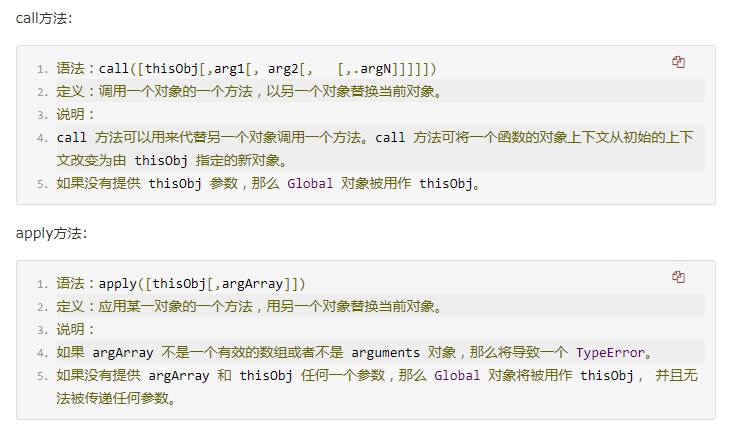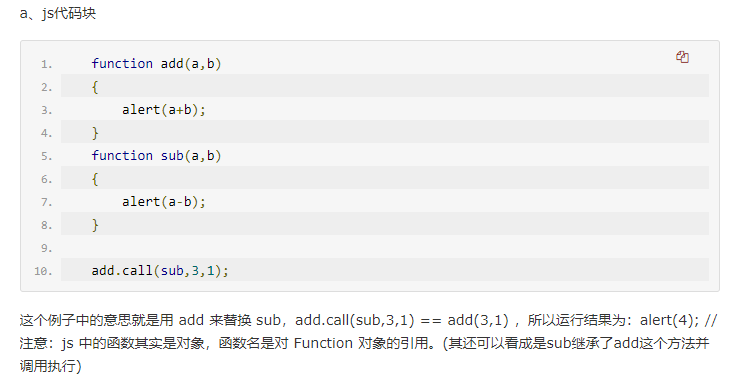apply( )与 call( ) 的区别
JavaScript中的每一个Function对象都有一个apply()方法和一个call()方法
语法
/*apply()方法*/ function.apply(thisObj[, argArray]) /*call()方法*/ function.call(thisObj[, arg1[, arg2[, [,...argN]]]]);
定义

共同之处
都“可以用来代替另一个对象调用一个方法,将一个函数的对象上下文从初始的上下文改变为由thisObj指定的新对象”。
不同之处
apply:最多只能有两个参数——新this对象和一个数组argArray。
如果给该方法传递多个参数,则把参数都写进这个数组里面,当然,即使只有一个参数,也要写进数组里。
如果argArray不是一个有效的数组或arguments对象,那么将导致一个TypeError。如果没有提供argArray和thisObj任何一个参数,那么Global对象将被用作thisObj,并且无法被传递任何参数。
call:它可以接受多个参数,第一个参数与apply一样,后面则是一串参数列表。
这个方法主要用在js对象各方法相互调用的时候,使当前this实例指针保持一致,或者在特殊情况下需要改变this指针。
如果没有提供thisObj参数,那么 Global 对象被用作thisObj。
实际上,apply和call的功能是一样的,只是传入的参数列表形式不同。
示例代码

(1)基本用法
function add(a,b){
return a+b;
}
function sub(a,b){
return a-b;
}
var a1 = add.apply(sub,[4,2]); //sub调用add的方法
var a2 = sub.apply(add,[4,2]);
alert(a1); //6
alert(a2); //2
/*call的用法*/
var a1 = add.call(sub,4,2);
(2)实现继承
function Animal(name){
this.name = name;
this.showName = function(){
alert(this.name);
}
}
function Cat(name){
Animal.apply(this,[name]);
}
var cat = new Cat("咕咕");
cat.showName();
/*call的用法*/
Animal.call(this,name);
(3)多重继承
function Class10(){
this.showSub = function(a,b){
alert(a - b);
}
}
function Class11(){
this.showAdd = function(a,b){
alert(a + b);
}
}
function Class12(){
Class10.apply(this);
Class11.apply(this);
// Class10.call(this);
//Class11.call(this);
}
var c2 = new Class12();
c2.showSub(3,1); //2
c2.showAdd(3,1); //4
原文:
https://www.cnblogs.com/lengyuehuahun/p/5643625.html
--- 所有笔记仅作个人整理,非全部原创,内容源自网络 ---


